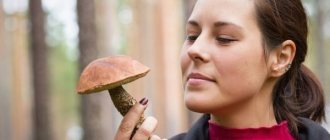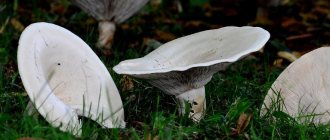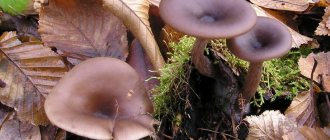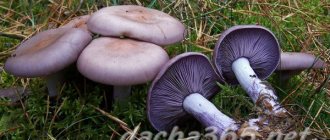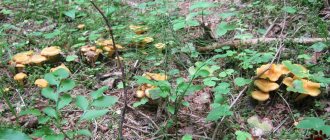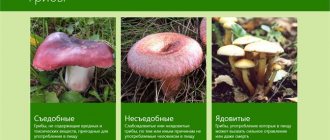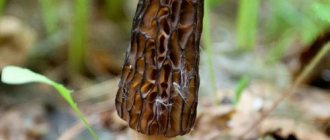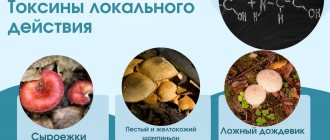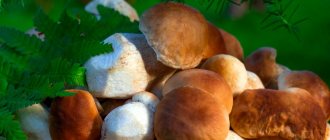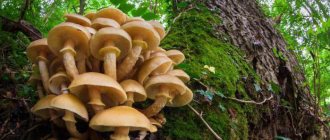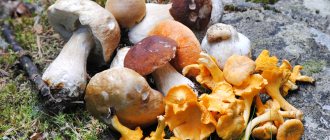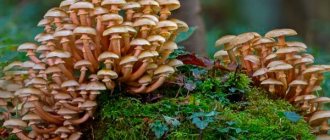Have you seen an individual with a thick purple leg and a brown cap on the edge and don’t know what this species is called? In this article we will look at how to distinguish lilac-colored specimens from each other and whether they are poisonous.
Most likely, such mushrooms are called violet row, violet cobweb, lilac or amethyst or others. Let's find out what are the features of purple mushrooms and their appearance, at what time of year and in what places they grow.
Purple web mushroom
Violet cobweb, from the Latin Cortinarius violaceus, belongs to the category of edible mushrooms. The popular name is purple marsh grass or fat woman. This mushroom from the genus Cobwebs and the family Cobwebs or Cortinariaceae grows in coniferous and deciduous forests and has the following characteristics:
- the convex or cushion-shaped cap has a diameter of up to 15 cm;
- old specimens have an outstretched, felt-scaled cap with wavy edges, dark purple in color;
- wide, sparsely spaced plates grow into teeth and have a dark purple color;
- the height of the leg does not exceed 120 mm with a thickness of 20 mm;
- the upper part of the leg is covered with small scales;
- the lower part of the stalk has a tuberous thickening;
- the structure of the leg is fibrous, brownish or dark purple, with a slightly lilac surface;
- whitish or bluish, with a purple tint, the pulp has a pronounced nutty taste;
- The mushroom aroma of the pulp is almost completely absent.
The edible purple cobweb is very well suited for preparing elegant first and second courses. Despite the fact that the taste of the cobweb is quite average, it is eaten boiled and fried, and is also used for pickling and salting.
The marshland forms mycorrhiza with deciduous and coniferous trees such as pine, birch, spruce, beech and oak. The period of mass fruiting of the purple cobweb occurs in August and lasts until mid-October. Most often it can be found on humus and acidic soils, fallen leaves and mossy soil.
Useful properties and restrictions on use
You may be interested in: How do edible talkers differ from false mushrooms? How many days after rain do mushrooms grow? Bitter mushroom: photo and detailed description
Purple russula and other similar species contain many vitamins that are essential for the body: copper, manganese and zinc. They also contain ergosterol and stearic acid. This group of mushrooms has many medicinal properties and is widely used in medicine:
- used in the production of antibiotics and medications to control hypoglycemia;
- reduce glucose levels;
- help fight fungal diseases;
- stabilize the gastrointestinal tract;
- strengthen the immune system and protect the body from infectious diseases;
- stabilize the nervous system;
- prevent fatigue and improve overall health.
These mushrooms have a positive effect on the body, but under certain conditions they cannot be eaten. These include:
- individual intolerance and allergic reaction;
- serious diseases of the stomach and gastrointestinal tract;
- childhood.
Fruits collected near roads, industrial facilities and contaminated areas should also not be eaten. The fruits easily absorb toxic substances and become unsuitable for consumption.
Purple mushrooms are one of the most unusual both in terms of external characteristics and taste. Despite the non-standard color, most of them are edible, and poisonous similar species are easily distinguished by their specific smell.
Purple dog
Peziza violacea belongs to the genus Peziza or Peziza and the family Pezizaceae or Pezizaceae. The fruiting bodies of the violet arctic fox grow in relatively large groups in areas after fires and bonfires. Peak fruiting occurs in spring and the first half of summer.
Characteristics and morphological description of mushrooms called purple petitsa:
- cup- or saucer-type discomycete;
- the average diameter of the shallow fruiting body is about 5-30 mm;
- the smooth inner part of the spore-bearing surface is lilac, violet or reddish-violet in color;
- the outer part is paler than the inner side, grayish-lilac or pale brown;
- the presence of a false pedicle may be observed;
- pale lilac color, rather thin and brittle pulp, does not have a pronounced mushroom taste and aroma.
The mushroom does not belong to the category of poisonous, but is collected by lovers of “quiet” hunting and is used for food purposes extremely rarely, due to the lack of decent taste and thick, fleshy pulp. Petsitsa is the closest relative of strings and morels, therefore it is used not only fried and salted , but also as a decoration for salads, which will significantly enrich the aesthetic side of ready-made dishes.
Gray row, edible and poisonous: how to distinguish?
Gray row, edible and poisonous: how to distinguish?
It is worth noting that in different reference books some types of mushrooms are described differently.
- In one reference book, a particular species may be listed as edible, in another - conditionally edible, and in a third - poisonous.
- Therefore, experienced mushroom pickers rely only on their experience. They already know what smell edible mushrooms have and how bad mushrooms that are unsuitable for food smell. But it is better not to take risks and not to collect mushroom fruits, which can be confused with poisonous ones.
- For example, gray row, completely white (cap and leg), translucent and brindle are considered poisonous.
Tip: To avoid mistakes, collect only rows of bright purple color, as well as crowded ones with dark and brown skin on the cap, yellow-red and giant ones. All of them are different in color, cap diameter and stem length. It is very easy to confuse the gray and purple-legged row with edible individuals.
Remember : Poisonous mushrooms of this species are more dangerous than fly agaric!
Now let's take a closer look at each mushroom of this species to know what the edible and poisonous rows look like.
Row purple
The mushroom called violet row is known to many mushroom pickers as naked or violet lepista, and among the people it is affectionately called cyanosis or titmouse. Lepista nuda belongs to the category of conditionally edible mushrooms, the genus Lepista and the family Oryadovaceae or Govorushka.
Such a fairly large mushroom, like row, has the following morphological description:
- the diameter of the fleshy cap does not exceed 16-18 cm;
- the cap is fleshy, hemispherical and convex in shape, with thin edges turned down;
- adult specimens have a convex-spread or depressed-shaped cap with curved edges;
- there are specimens with wavy-curved caps;
- the smooth surface of the cap has a characteristic gloss;
- the cap of a young mushroom has a bright purple color, and with age it tends to fade and acquire an ocher tint;
- fleshy type, the pulp is sufficiently dense and has a light purple color;
- The pulp is characterized by the presence of a rather weak but pleasant taste and aroma, reminiscent of anise;
- the plates are quite thin, often arranged with adherent teeth or almost free type, purple in color;
- the legs are dense, cylindrical in shape, with a slight thickening at the base;
- the surface is smooth, with longitudinal fibers;
- Characteristic is the presence of a flocculent coating under the cap and purple pubescence at the base of the stem.
Similar species [edit | edit code]
- Lilac-legged row ( Lepista saeva
) grows mainly in open areas - Violet row ( Lepista irina
) is pinkish in color, the flesh is white - Purple webwort ( Cortinarius violaceus
), like other webworts, is distinguished by the presence of a cobwebby cover under the cap at a young age, brown spore powder - Lilac varnish ( Laccaria amethystina
) is much smaller in size, with a thin fibrous stalk and white spore powder
- White-purple webwort ( Cortinarius alboviolaceus
) with a remnant peduncle that is often stained rusty brown - Goat's webweed ( Cortinarius traganus
) is distinguished by its bitter yellow flesh with an unpleasant musty odor. - Pure mycena ( Mycena pura
) [5] is distinguished by a streaked cap edge and white spore powder.
Features of purple rows (video)
The purple rower belongs to the category of saprophytes, and its fruiting bodies grow on the surface of rotting leaf litter. It has sufficient resistance to cold weather and bears fruit from mid-September until the onset of significant cold weather in October-November.
The conditionally edible purple row mushroom is of fairly good quality, but before using it for food, pre-cleaned and washed mushrooms should be subjected to heat treatment in the form of boiling for 15-20 minutes. Eating violet grass without prior boiling often causes quite severe stomach upsets . Among other things, preliminary boiling of the fruiting bodies of the row allows you to eliminate the specific smell and taste characteristic of all mushrooms growing on rotting organic matter.
Description and photos
A distinctive feature of the culture, which gives the fruiting bodies their name, is the ability to grow in rows of colonies (sometimes the rows form a circle, popularly called a witch’s circle). A favorable habitat for the forest gifts we are considering is a deciduous-coniferous, mixed forest, dominated by trees such as spruce.
The growing season for edible representatives of the family is from late August to late September. Beginning in October, poisonous twins of the rower appear in the forest; the only chance to distinguish them from the “real” ones is to carefully analyze the smell of each collected specimen.
Amethyst lacquer
An edible, but quite rare mushroom in our country called lilac or amethystina, from the Latin Laccaria amethystina, belongs to the genus Lakovitsa and the family Rowaceae. The mushroom grows on moist soils of forest zones and has the following external characteristics:
- the diameter of the cap varies between 10-50 mm;
- young specimens have a hemispherical shape;
- old fruiting bodies of amethyst varnish have a flat cap;
- the coloring of the surface of the cap is lilac-violet, but with age it is prone to strong fading;
- the plates are quite thick, sparsely spaced, lilac-violet in color;
- in mature specimens of fruiting bodies, the plates are whitish-powdery and descending along the stalk;
- leg with longitudinal fibers, characteristic purple coloring;
- The pulp is thin, lilac-violet in color.
Mushrooms can be used to prepare both first and second mushroom dishes.
Places of growth in Russia
Purple mushrooms are not uncommon in Russian forests. They can be found in the Moscow region and in the Leningrad region, in the Primorsky and Krasnoyarsk territories. In the most common cases, there are rowers and cobwebs, which grow in the territory of mixed and deciduous forests. They can be seen near pines, spruces, beeches, oaks or birches. Also in the Leningrad region and other regions of Russia, amethyst varnish is found. It grows in swampy areas with high humidity, near mosses.
Color-changing mushrooms
Mushrooms that acquire a purple color are few in number, but are worth mentioning. You should not be surprised if, after cooking, the fruiting bodies of mushrooms such as goat mushrooms turn purple. The pulp of these mushrooms, when exposed to heat treatment, becomes a very unusual, interesting cherry-purple color.
In addition, the fruiting bodies of boletus, as well as some varieties of russula, turn blue-violet during the cooking process, which is due to the presence of the enzyme tyrosinase in the pulp.
Edible and poisonous row mushrooms: how to tell the difference?
Edible and poisonous row mushrooms: how to tell the difference?
Before going into the forest, you need to understand how to distinguish between edible and poisonous rows. Most varieties are safe and can be fried or boiled for eating.
But how can one distinguish between edible and poisonous row mushrooms? This is very difficult to do, since the mushrooms are very similar in appearance, so it is important to learn the characteristic features of each species.
- Poisonous mushrooms have flat, almost all species have perfectly even white caps. But there are representatives who have a tubercle. The main difference between poisonous rows is the unpleasant pungent odor that even makes you wince.
- Edible mushrooms look attractive. Their caps and legs have different colors (pink, purple, lilac, gray and others). Under the cap there are bright plates of a beautiful color. The flesh of the edible mushroom will be the same shade as the plates under the cap.
Interesting: Experienced mushroom pickers note that some types of row mushrooms have a unique taste. Therefore, you need to try to cook each of them.
When does the bluefoot appear?
The fruiting bodies are resistant to cold, so they can be found even in late autumn and even in December. But other types of mushrooms do not have this ability, except for winter mushrooms. The lilac-legged row grows on moist, humus-enriched alkaline soils and belongs to the category of southern mushrooms. Widespread in Europe and America, it loves open areas - forest glades, river banks, meadows, pastures and farms.
Sometimes found in forests, especially near deciduous trees. Bluefoot grows in colonies, forming quite large circles or rows. This allows you to pick a whole basket of mushrooms, practically without leaving one place. The bluefoot is distributed throughout Russia; it can be found both in the Moscow region and in the Ryazan region. The fruiting season begins in April and lasts until the end of October, but the most active time is autumn. The lilac-legged row is common in the territories of Russia, which belong to Eastern Europe, as well as in the southern regions.
The blue leg fell in love with coniferous forests and pine forests. They grow side by side, on islands, so you can quickly collect a whole basket without moving from place to place. Purple-footed creatures hide under fences and under fallen leaves. It is known that each type of mushroom prefers to grow under a particular tree. Rowing is an exception to the rule, and chooses soil that is well fertilized with manure. The first bruises appear in mid-spring. August and September are the best times for picking mushrooms. It should be remembered that after rain, the pads become unpleasant to the touch and slip in your hands.
Therefore, there is no need to collect them in wet weather. Below is a list of useful recommendations:
- Mushrooms grow only in sunlit areas. You should not look for them in the dark density of the forest;
- In order not to spend a lot of time at home on processing, after picking a blue leg, you should immediately cut off the stem of the mushroom from the bottom;
- The spores, which are located on the lamellar section of the row, complicate digestion. Once in the stomach, they can cause poisoning. Therefore, the lower part of old mushrooms must be cut off;
- Mushroom pickers advise collecting mushrooms before 12 noon.
You should not collect very old or wormy mushrooms - they can cause poisoning. There are mushrooms that look like bluepods. It is important to know what they look like so as not to confuse edible boletus with poisonous ones:
- Purple row. It has a cap of the same color, which is very reminiscent of a real blueleg. But in the latter it is a little purple, while in the former the color is more saturated and bright;
- Gossamer violet. It resembles a blueleg, but has a characteristic “veil” at the bottom of the cap;
- The row is weedy. Similar to the podtavnik, but much smaller.
The listed mushrooms are considered conditionally edible. But there is another representative that looks like a blue leg. It is called the white-violet spider web and is poisonous. When broken, you can see that its flesh has a yellow tint. Often there are purple spots on it.
